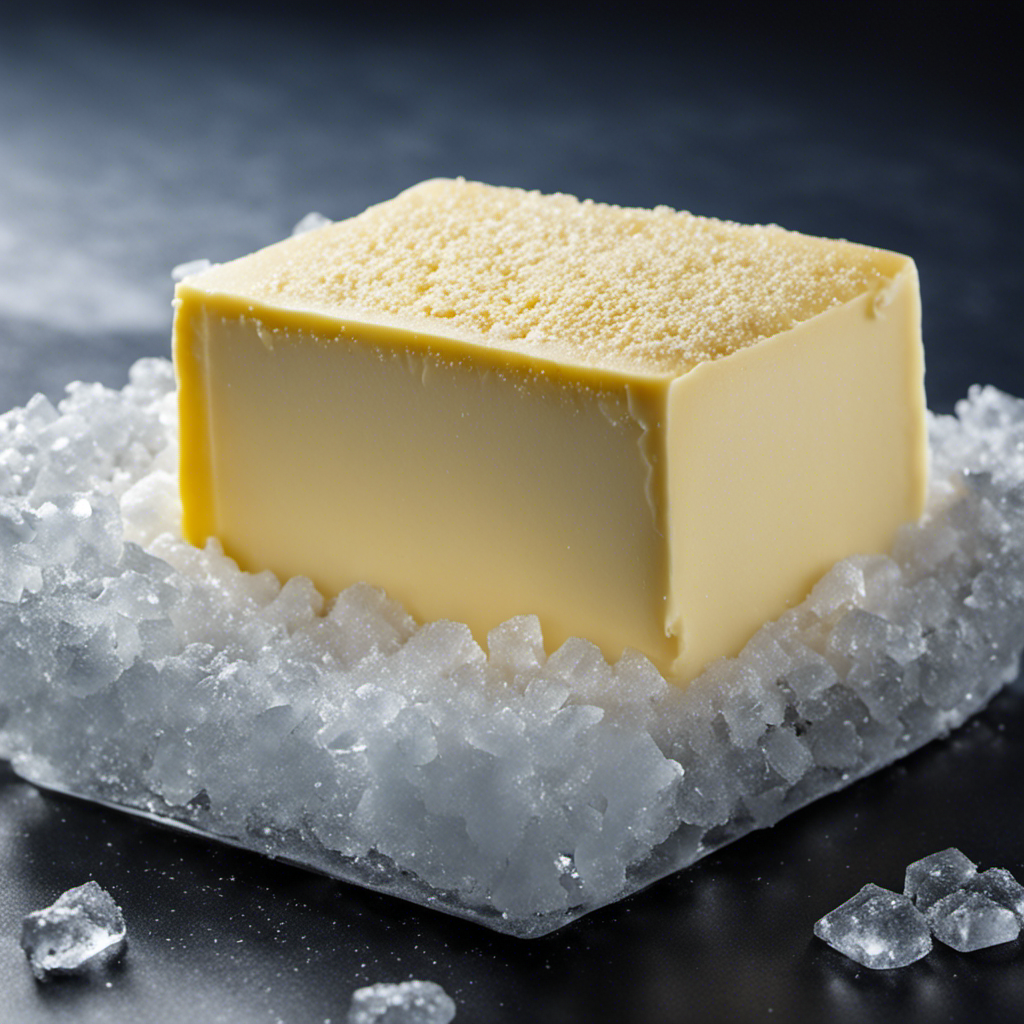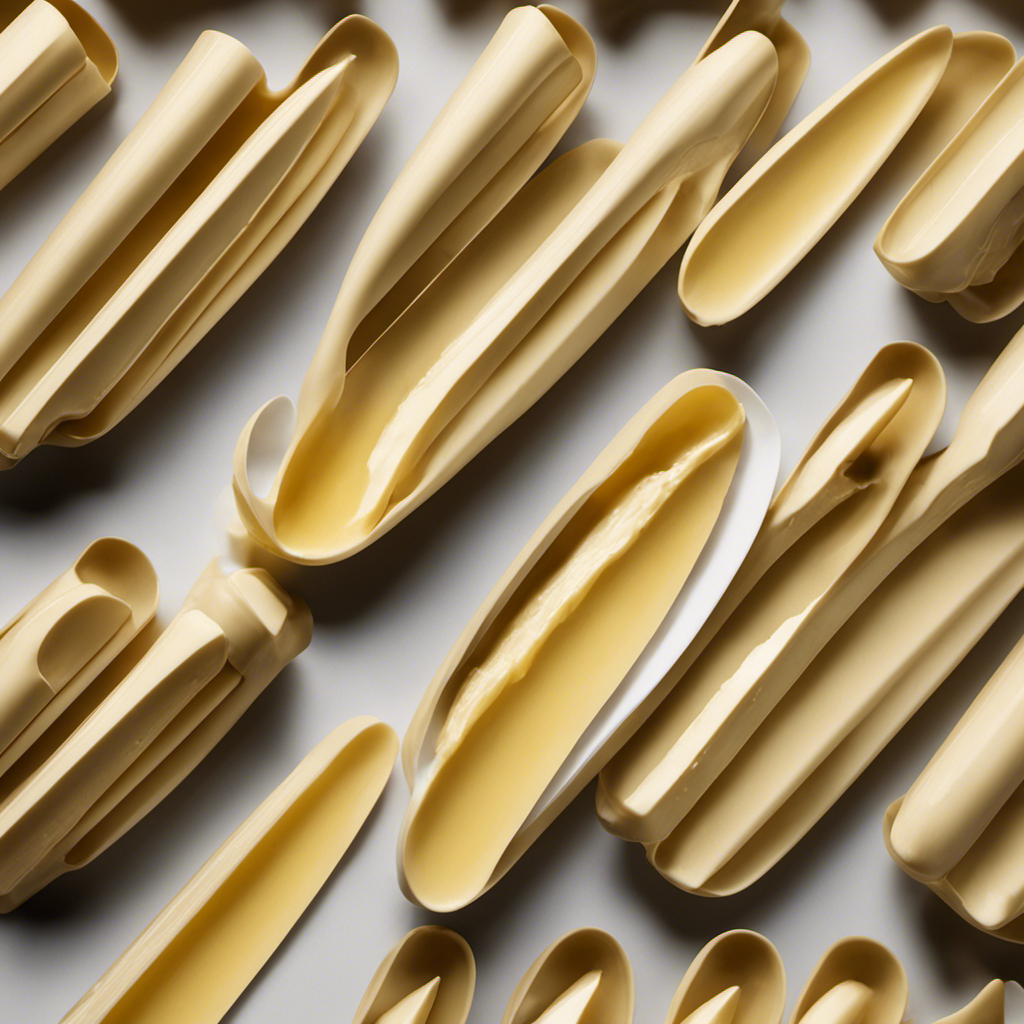Ever get that wave of anxiety when you notice your beloved butter’s expiration date has passed? Wondering if it’s still safe to indulge in its velvety delight? Worry no more!
In this article, we’ll give you the lowdown on just how good butter is after its expiration date. We’ll delve into the science behind its shelf life, explore the factors that affect its quality, and provide you with expert tips on storing it properly.
So grab your toast and let’s butter up the truth!
Key Takeaways
- Butter is safe to consume after its expiration date, but careful examination of its appearance, smell, and taste is necessary before consuming.
- Refrigeration can extend the shelf life of butter, while freezing can also prolong its shelf life but may alter its texture.
- Bacterial growth, such as Salmonella or E. coli, is a major concern with expired butter, increasing the risk of foodborne illnesses.
- Proper storage, including storing butter in the refrigerator and protecting it from air, light, and moisture, is important for maintaining butter quality and safety.
Shelf Life of Butter
Butter is still safe to consume after its expiration date. The shelf life of butter can be extended through various preservation techniques. One common method is refrigeration, which slows down the growth of bacteria and molds that can cause spoilage. By keeping butter at a temperature below 40°F (4°C), you can significantly prolong its freshness.
Another technique is freezing, which can extend the shelf life of butter for up to several months. However, it’s important to note that freezing may alter the texture of butter, making it less suitable for certain uses like spreading.
When consuming expired butter, it is crucial to carefully examine its appearance, smell, and taste. If it looks and smells normal, and there are no signs of mold or off flavors, it should be safe to consume. However, if you notice any unusual changes, it is best to discard the butter to avoid potential health risks.
Factors Affecting Butter Quality
When considering the factors that affect the quality of butter, there are several key points to consider.
Firstly, the impact of storage temperature cannot be understated, as improper temperatures can lead to spoilage and the growth of harmful bacteria.
Secondly, the packaging and exposure of butter can also play a significant role in its quality, as exposure to air, light, and moisture can accelerate spoilage.
Lastly, variations in butterfat content can impact its taste, texture, and overall quality, with higher butterfat content generally being preferred.
It is essential to understand these factors to make informed decisions about the safety and quality of butter, especially when considering consuming it after its expiration date.
Storage Temperature Impact
Storing butter at higher temperatures can negatively affect its quality after the expiration date. Proper storage conditions are crucial in maintaining the freshness and safety of butter. When stored at temperatures above 70°F (21°C), butter becomes more susceptible to bacterial growth. Bacteria, such as Salmonella and E. coli, can multiply rapidly in warm environments, increasing the risk of foodborne illnesses.
The expiration date serves as a guideline for consuming butter before its quality starts to decline. Consuming expired butter can pose health risks, especially if it has been stored improperly. The warmer the storage temperature, the faster the deterioration of butter’s flavor, texture, and nutritional value.
It is essential to store butter in a cool and dry place, such as a refrigerator, to prevent bacterial growth and maintain its quality for a longer period.
Packaging and Exposure
The quality of butter can be negatively impacted if it is exposed to improper packaging or storage conditions. Proper packaging alternatives and butter preservation techniques are crucial for maintaining its freshness and taste.
When butter is not stored in airtight packaging, it can absorb unwanted odors and flavors from the surrounding environment, leading to a decrease in quality. Exposure to air can also cause oxidation, resulting in rancidity and an off-putting taste.
To prevent these issues, it is recommended to store butter in its original packaging or in airtight containers in the refrigerator. Additionally, some packaging alternatives, such as foil or parchment paper, can provide an extra layer of protection against light and air.
Butterfat Content Variations
Butterfat content can vary depending on the type of butter being produced. The butterfat composition is an important factor in determining the nutritional value of butter.
Butter with higher butterfat content generally has a richer taste and creamier texture. It also contains more calories and saturated fats compared to lower butterfat content butter.
However, it is important to note that consuming expired butter, regardless of its butterfat content, can pose potential risks to your health. Expired butter may harbor harmful bacteria or become rancid, leading to foodborne illnesses or unpleasant taste.
Therefore, it is recommended to avoid consuming butter after its expiration date to ensure safety and maintain the quality of the product.
Now, let’s move on to discuss the signs of spoiled butter.
Signs of Spoiled Butter
When it comes to determining whether butter is spoiled or not, there are a few key indicators to look out for.
Firstly, changes in color can be a clear sign of spoilage, with butter turning a yellowish or brownish hue.
Secondly, the smell and taste of rancidity are important factors to consider, as rancid butter has a distinct unpleasant odor and flavor.
Lastly, the growth of mold on butter is a definite red flag, as it can cause illness and is a clear indication that the butter has gone bad.
Color Changes Indicating Spoilage
You can tell if the butter has spoiled by looking for changes in its color. Color changes in butter can indicate spoilage and a decrease in quality. Here are three color changes to look for that may indicate spoiled butter:
-
Yellow to white: Butter that has turned from its usual yellow color to a pale white may be a sign of spoilage. This could indicate the growth of mold or bacteria.
-
Darkening or discoloration: If the butter has developed dark spots or has an overall darker appearance, it may have gone bad. This could be caused by oxidation or the breakdown of fats.
-
Green or blue streaks: These colors are not normal in butter and may indicate the presence of mold. If you see green or blue streaks, it is best to discard the butter.
Rancid Smell and Taste
If the butter has a rancid smell and taste, it is a clear indication that it has gone bad and should be discarded. Rancidity in butter occurs when the fats in the butter break down, resulting in an unpleasant smell and taste.
This can happen when butter is stored improperly or past its expiration date. Consuming rancid butter can lead to digestive issues and potentially harmful effects on your health.
It is important to note that the expiration date on butter is there for a reason, as it signifies the point at which the butter may no longer be safe to consume. Therefore, it is recommended to always check for any signs of rancidity before using butter, and if detected, it is best to discard it.
Mold Growth on Butter
The presence of mold on butter is a clear sign that it has spoiled and should be thrown away. Mold growth occurs when the butter is exposed to moisture and warmth, creating an ideal environment for mold spores to thrive. Consuming moldy butter can pose health risks, as molds can produce mycotoxins that can cause allergic reactions, respiratory problems, and even food poisoning.
To prevent mold growth and ensure butter preservation, here are three important tips:
- Store butter in the refrigerator at a temperature below 40°F (4°C) to inhibit mold growth.
- Keep butter in an airtight container to prevent moisture and mold spores from contaminating it.
- Check the expiration date and discard any butter that has exceeded it, as it is more susceptible to mold growth.
Safety Concerns With Expired Butter
Expired butter may not be safe to consume due to potential bacterial growth. When butter reaches its expiration date, it means that it is no longer guaranteed to be safe for consumption. As a food safety specialist, it is important to inform you about the potential risks associated with consuming expired butter. Bacterial growth is a major concern when it comes to expired food products, including butter. When butter is past its expiration date, harmful bacteria, such as Salmonella or E. coli, may start multiplying, increasing the risk of foodborne illnesses. Therefore, it is recommended to discard butter that has exceeded its expiration date to avoid potential health hazards.
Considering the importance of food safety, it is crucial to understand the significance of expiration dates and their role in maintaining the quality and safety of food products.
Properly storing butter can help extend its shelf life and maintain its quality.
Tips for Properly Storing Butter
Storing butter in the refrigerator can help prolong its freshness and maintain its quality. To ensure proper butter storage and prevent spoilage, follow these tips:
-
Keep butter in its original packaging or wrap it tightly in foil or wax paper to protect it from absorbing odors from other foods in the fridge.
-
Store butter in the coldest part of the refrigerator, which is usually the back of the bottom shelf.
-
Use a covered butter dish or container to protect the butter from exposure to air and moisture.
Properly storing butter will help extend its shelf life and prevent it from going bad. By maintaining its freshness, you can enjoy the full flavor and quality of butter even after its expiration date.
Now, let’s explore some creative uses for expired butter.
Creative Uses for Expired Butter
To make the most of expired butter, you can repurpose it in various ways to add richness and flavor to your cooking and baking. While it is important to consider the potential risks associated with consuming expired butter, there are some creative uses that can still be enjoyed safely.
One option is to use expired butter in unconventional recipes, such as incorporating it into homemade bread or pastries for a deliciously rich taste. Another fun idea is to create butter sculptures, where expired butter can be shaped into intricate designs to add an artistic touch to your dining table.
However, it is crucial to note that these uses should only be considered if the butter has been properly stored and does not show any signs of spoilage, such as a rancid smell or mold growth. Always trust your senses and exercise caution when using expired butter.
Conclusion
In conclusion, consuming butter after its expiration date may not be the best idea. Scientific research and established guidelines suggest that expired butter can potentially pose health risks due to the growth of harmful bacteria.
While some people may argue that expired butter is still safe to consume, it is important to consider the potential risks involved. As a food safety specialist, my objective and unbiased recommendation would be to prioritize your health and discard any butter that has exceeded its expiration date.
It’s better to be safe than sorry, and find alternative uses for expired butter in creative ways.









